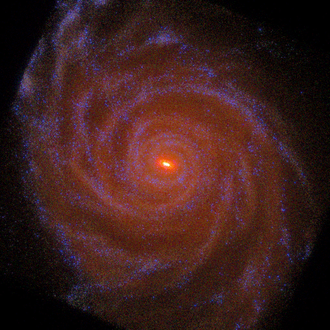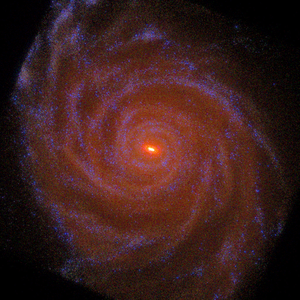Milky Way shows gamma ray excess due to dark matter annihilation
New research shows that dark matter has a different distribution in our galaxy than previously thought and that advances dark matter’s status as potential source of the observed gamma ray excess in the Milky Way’s center. High-resolution simulations reveal that the dark matter distribution in the inner galaxy is not spherical, but flattened and asymmetrical. The findings confirm the theory that the gamma ray excess is due to dark matter annihilation.
Scientists have long suspected dark matter annihilation to be a source of these rays, but the rays’ spatial spread did not match the arrangement of dark matter they had predicted. Another theory argues that ancient millisecond pulsars could produce the rays. Here, researchers modelled the formation of Milky Way-like galaxies under environmental conditions similar to those of Earth’s cosmic neighborhood, thereby reproducing simulated Milky Way-like galaxies that bare strong resemblance to the real thing. They found that dark matter does not radiate outwards from the Galactic Center but is instead organized similar to that of stars, meaning the former could just as equally have produced the excess gamma rays.
“When the FERMI space telescope pointed to the galactic centre, the results were startling. The telescope measured too many Gamma rays, the most energetic kind of light in the universe. Astronomers around the world were puzzled, and competing theories started pouring in to explain the so-called "gamma ray excess", states Noam Libeskind from the Leibniz Institute for Astrophysics Potsdam (AIP). After much debate, two ideas rose to the fore: either these gamma rays were the result of millisecond pulsars (ultra-dense neutron stars that spin thousands of times per second) or from dark matter particles smashing into each other and annihilating. Both theories have their drawbacks. However, new results led by scientists at the AIP collaborating with the Hebrew University in Israel and Johns Hopkins University in the USA have shed new light on this problem, effectively confirming the theory that the gamma ray excess is due to dark matter annihilation.
The Milky Way galaxy has long been known to live in a so-called dark matter halo, a spherical region filled with dark matter around it. However, the extent to which this halo is aspherical or ellipsoidal has not been appreciated. Moorits Muru, lead author of the paper, says: “We analysed simulations of the Milky Way and its dark matter halo and found that the flattening of this region is sufficient to explain the gamma ray excess as being due to dark matter particles self-annihilating. These calculations demonstrate that the hunt for dark matter particles (that can self- annihilate) should be encouraged and bring us one step closer to understanding the mysterious nature of these particles.”
Further information
Fermi-LAT Galactic Center Excess Morphology of Dark Matter in Simulations of the Milky Way Galaxy
https://doi.org/10.1103/g9qz-h8wd
Images
Simulated Milky Way Galaxie
Big screen size [1000 x 1000, 2.2 MB]
Original size [1024 x 1024, 2.4 MB]




